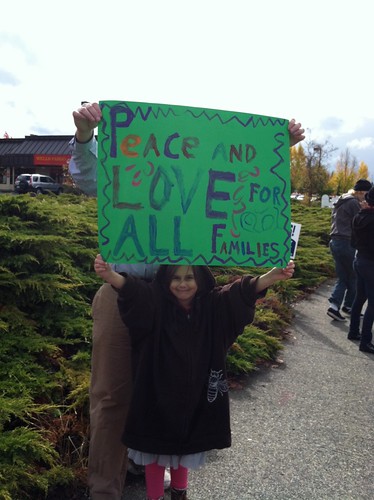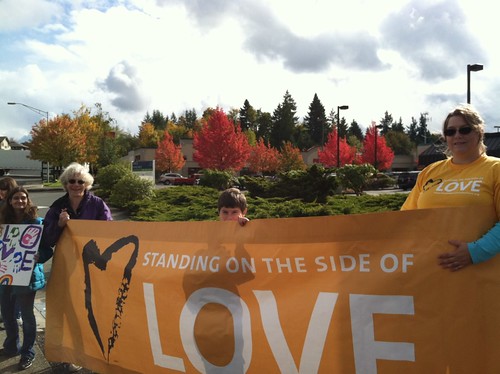
 Our High School youth group decided they wanted to do something to support Yes on Referendum 74 (our state's ballot measure that asks us to vote to affirm the marriage equality law the legislature already passed). Hypatia was hanging out with me last week as I led the youth group meeting, and she was inspired to join in. This week she made this sign at home, and today she joined the group on the corner of a busy intersection as we all stood and waved our signs and our big Standing on the Side of Love banner. (That's her dad behind her helping her keep her sign up in a strong wind).
Our High School youth group decided they wanted to do something to support Yes on Referendum 74 (our state's ballot measure that asks us to vote to affirm the marriage equality law the legislature already passed). Hypatia was hanging out with me last week as I led the youth group meeting, and she was inspired to join in. This week she made this sign at home, and today she joined the group on the corner of a busy intersection as we all stood and waved our signs and our big Standing on the Side of Love banner. (That's her dad behind her helping her keep her sign up in a strong wind).I was struck by how her action today was just perfect with what my 1/2 sermon (I shared the morning with another speaker) this morning was all about:
Bringing Justice Home: Part 1
The story I told today was one that
I saw done in a workshop at General Assembly this year. General Assembly is the annual national
gathering of Unitarian Universalist congregations, and this year it was a
themed “Justice” GA in response to it’s location in Phoenix, Arizona.
I think it is telling that in the
story the first group to stand in solidarity were children. This speaks truth to me, not because I
think children are naturally always kind and just – in fact children and
adolescents are sometimes incredibly cruel to each other. No – it is not because they are
better-natured than adults, but rather because they are not numbed to injustice
yet.
A couple years ago, my son hit that
stage of reading where he was working out all the signs he saw as we drove
around town. As I was sitting at a
red light, he was working out what the handmade cardboard sign being held by
the person on the street corner said.
“Homeless – need help”, it said, and he read that out loud just as the
light changed and I drove on about our business. My daughter, the younger child, cried out “that person said
they needed help – why aren’t you helping them!?”.
Indeed, why am I not helping
them? Because I don’t want to
encourage street corner begging?
Because I am afraid that giving them money won’t actually help them?; because
I am too busy, in too much of a hurry?
These are all possible reasons for any of us to pass by on any given
day. But the reason, the primary
reason, I believe, is that we cease to notice the injustices and sad sights
that we see too often. We become
numb to it all.
Our children and youth bring new
eyes, and as such they can see more than we do. They can also speak that truth which they see, much as the
small child does in the story of The Emperor’s New Clothes when they ask “why
is the Emperor naked?”. Too often,
the adults in the crowd are afraid to mention that the Emperor is, in fact,
naked.
How do we get so numb, so blind, so
afraid to act? It seems that in
fact this is not the natural state of the human brain, as recent studies have
shown that when people look at images of others experiencing pain or violence,
the viewers have the same parts of their brain activated as if they were
looking at pictures of their own children. In similar studies, when people acted to help another the
same part of their brain showed activity as it would if they were experiencing
personal pleasure. These sort of
studies have led some academics to propose that humans are naturally
compassionate and cooperative, and that altruistic behavior has a biological
foundation.
And then other studies, such as that by Pearl and Samuel Oliner’s
study of Germans who helped rescue Jews during the Nazi Holocaust, have found
that memories of growing up in a family which prioritized compassionate and
altruistic behavior had a strong correlation with future adult action.
With this in mind, I believe that
each action I take in front my children – and every action that any one of us
takes in front of a child – is important not just because of what that action
can accomplish today, but because of what sort of future action will result
from my modeling. Realizing that
it was not emotionally and developmentally appropriate for my children to pass
by a person on the street asking for help, I helped them create care packages
that we now keep in our car and can give to anyone we see on the street asking
for help.
As poet and activist Wendell Berry
has written: “Protesters who hold out longer have perhaps understood that
success is not the proper goal. If
protest depended on success, there would be little protest of any durability or
significance. History simply
affords too little evidence that anyone’s individual protest is of any
use. Protest that endures, I
think, is moved by a hope far more modest than that of public success: namely,
the hope of preserving qualities in one’s own heart and spirit that would be
destroyed by acquiescence.”
I feel that action is needed to
preserve those qualities in my heart and spirit, and also in the heart and
spirit of all who look to me as a model, those like my own children. And when I think about the ripples of
influence that all those hearts and souls living into their best selves may
lead to, I have to say that it is impossible to judge the success of anyone’s individual
single action.
Going back to psychological
research we find the phenomenon of learned helplessness. Learned helplessness is the phenomenon
of an animal or human who has repeatedly had a negative experience
internalizing the idea that they are helpless to change that experience, and
consequently ceasing to even try to make a positive change. If we repeatedly experience ourselves
as helpless to effect change, we may internalize this sense of learned
helplessness and just stop trying.
Learned helplessness is, of course, a self-fulfilling prophecy, since we
will never effect change if we don’t even try.
I realized at one point with my
children that I have learned helplessness. We were listening to an NPR story about a controversial
death penalty case, which sparked a family discussion of the death
penalty. My son was horrified that
we would think it was right to ever kill anyone, and I sympathized with his
point of view. But my knee-jerk
response, the one that ran through my mind was, “yeah, I used to care about
that too, but it’s hopeless. Nothing
will ever change, so we should just change the channel.”
Fortunately, I remembered how
important it is to empower children, rather than to downplay their natural
impulses toward compassion and justice-seeking. It can be so hard to hold onto our impulse toward justice,
and there will be enough discouraging experiences for the kids in their lives –
one of those discouraging experiences does not need to be caused by me. Responding to his interest in this
issue, I helped him write a letter that we sent to several political
leaders. Did his action make a
difference? Perhaps not. Did it make a difference to him? Yes. It was one of
those actions that sustained the qualities of compassion and justice-seeking in
his heart and soul.
It is a well-worn cliché to say
that “the children are the future”, but as with many clichés there is a core of
truth in the saying. Whenever you
engage in justice-work alongside a child, you are making a double investment
with your time and energy. You are
making the world better today through your efforts, and you are helping to make
the world better in the future through the life-long values you are helping to
instill in that young person.
In General Assembly in June, I
attended a workshop called “Justice as a Family Value”. There were many people in attendance who
had impressive resumes of activisim and justice-work, but we spent most of our
time talking about our childhoods.
What did we experience in childhood that inspired us to live the values
of justice-seeking? One woman
remembered Socks. She remembered
that her mother would always buy extra socks, more than their family needed,
and would hand those out to homeless people. Was that personal sock project huge? I doubt it. However, it turned out to be huge in the life of this woman
who would grow up to do many many more actions to make the world a better
place.
My daughter asked me this summer
what I hoped the future would be like.
I gave her a description of my best and most hopeful version of our possible
future, and she smiled confidently in response. “Ok”, she said.
“Let’s do that.” That
youthful voice of optimism inspires me.
Yes, indeed, let’s all do that.

No comments:
Post a Comment